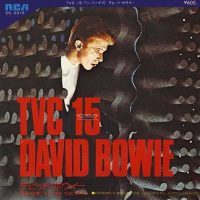 Written by: David Bowie
Written by: David Bowie
Recorded: September-November 1975
Producers: David Bowie, Harry Maslin
Released: 23 January 1976
Available on:
Station To Station
Live Nassau Coliseum ’76
Stage
Welcome To The Blackout (Live London ’78)
Personnel
David Bowie: vocals, tenor saxophone
Carlos Alomar, Earl Slick: guitar
Roy Bittan: piano
Harry Maslin: baritone saxophone
George Murray: bass guitar
Dennis Davis: drums
Geoff MacCormack: vocals
The poppiest moment on the David Bowie’s 10th studio album Station To Station, ‘TVC 15’ was a B-movie nightmare fantasy set to music.
The song was reportedly inspired by Iggy Pop who, while hallucinating on drugs, believed that a television set was consuming his girlfriend. In Bowie’s version the TV set became holographic and demonic, a passive observer who “just stares back unblinking”, yet the protagonist dreams of offering himself to the device: “One of these nights I may just jump down that rainbow way/Be with my baby, then we’ll spend some time together”
Another source of inspiration was surely The Man Who Fell To Earth, in which Bowie’s character, Thomas Jerome Newton, sits transfixed and tormented by a wall of television sets, all tuned to different channels.
The stuttering ‘oh-oh-oh-oh-oh’ vocal refrain, meanwhile, was purloined from the Yardbirds’ version of ‘Good Morning Little Schoolgirl’, a single in 1964.
One of the key element of ‘TVC 15’ was Roy Bittan’s rollicking New Orleans-style piano part.
The first time I ever met Roy was in New York while I was working with some band called Tracks or something. I met Roy, and we became fast friends. We were doing Station and it came up that we needed a piano player. David asked everybody in the band and I said, “You know what? Bruce Springsteen and the guys are staying at my hotel. My friend Roy is in the band. Why don’t I bring him down?” That’s what happened with Roy.
Rolling Stone, 25 January 2013
Bittan was a member of Bruce Springteen’s E Street Band, whose breakthrough album Born To Run had been released in August 1975, shortly before the Station To Station sessions.
I was staying at the Sunset Marquis in Los Angeles when we were on the Born To Run tour in 1975. David’s guitar player, Earl Slick, was a friend of mine. I bumped into him at the hotel and he said, ‘I can’t believe you’re here. We were just talking about you.’ David knew we were coming to town and he wanted a keyboard player.When I arrived the next day at the studio David said to me, ‘Do you know who Professor Longhair is?’ I said, ‘Know him? I saw him play at a little roadhouse in Houston about three weeks ago!’ I wound up doing an imitation of Professor Longhair interpreting a David Bowie song. We began with ‘TVC 15’ and I wound up playing on every song besides ‘Wild Is The Wind’. It must have only been about three days. It’s one of my favorite projects I’ve ever worked on.
Rolling Stone, 2015
In the studio
David Bowie wanted a fast and loose style of playing on ‘TVC 15’, aiming for feel over perfection.
Well, he didn’t want it organised at all, he really wanted it fucked up like when we did ‘Boys Keep Swinging’, kind of loose and stupid. But then when we got to the end, he really wanted it to drive home. During those times the drones of music was starting to get a bit vampy. By that I mean the music would stay in one place and just keep going. So, towards the end of the song, that’s what he wanted – ‘Oh my TVC 15, oh oh, TVC 15’. So we were just playing the rest of the song just to get to the end!
Strange Fascination, David Buckley
On the recording Bowie and producer Harry Maslin both played saxophones.
When David wasn’t there I did a little bit of everything. Working with Slick or working with Carlos or doing the percussion stuff that I wanted to do. But David was involved pretty much on a daily basis. It was rare that he wasn’t there. We worked together in collaboration. ‘TVC 15’ has the both of us playing saxophone on it; he played tenor and I played baritone.
David Bowie: A Life, Dylan Jones
The many vocal and instrument parts, some of which were on the same track at different points in the song, meant mixing ‘TVC 15’ was a complex affair. Maslin overcame this by mixing it in stages, which were edited together to create the master.
The project was mixed at The Hit Factory in New York which was my home studio and wherein I was chief recording engineer. We had a custom built console utilizing the now classic API 550 equalizers in each channel module. It had no automation, so like all mixing in those day, the mix was somewhat of a performance in itself. Every pass had small differences and sometimes it came to editing different takes together to achieve the ‘final’ mix. TVC 15 is a classic example of this. The 24 track tapes were packed with different instrument information ending up on the same track at times. This of course made it impossible to add EQ and dynamics processing to a track for a continuous mix pass. One cannot affect a piano, saxophone and maracas in the same manner; hence the song was mixed in sections. My assistant added a second pair of hands for the most demanding sections.
Who Can I Be Now? (1974–1976) book


